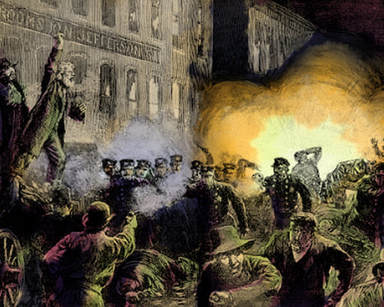 This day in history, May 4, 1886, saw possibly the most significant event in American labor history: Haymarket. Controversy churns over the details even now some 130 years later. In schools across the U.S. our kids are taught that anarchists, socialist and communists rioted that day. Haymarket Riot is the answer to a question on the Advanced Placement U.S. History exam. Socialist and Communists--the ultimate enemies of American ideals, and yet, what these workers wanted was simply to lay down their tools at five o'clock, go home and have dinner with their families. Sixty hour workweeks were the norm. 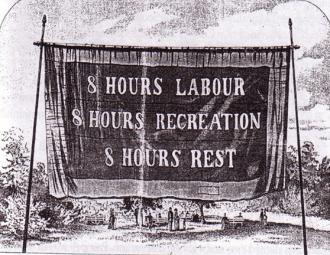 This was a case of labeling, the type still prevalent in America that allows us to immediately discount a group of people and their concerns. As you know, the words we choose to describe what we see are not idle, they determine what we see. One award-winning curriculum developer offers teachers a lesson plan on the Haymarket that asks students to "read like a detective" to gain a clear understanding of a newspaper article published the following day by the Chicago Hearld. Only this one source is offered on the subject and the event is called a riot by teachers following this guide. At the time, there were numerous English newspapers in Chicago, as well as German and Irish newspapers that would have reported on this event, many of the striking workers were German and Irish immigrants. 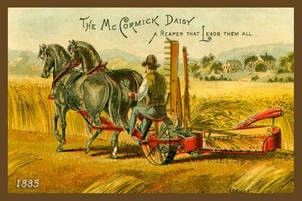 What happened in Haymarket, a public market square in Chicago, stemmed from a labor strike that started on May Day. More than 350-thousand workers across the country joined in demanding an 8-hour workday. Among them were machinists at Chicago's McCormick Reaper Company. They built a piece of farm machinery which had replaced scythes for cutting crops. Imagine how vastly the reaper improved farmers' productivity and increased the food supply for all Americans. McCormick locked out the striking workers and hired new men to take their jobs. When strikers gathered outside the plant to protest violence broke out between strikers, strikebreakers and police. It's unclear how many people were injured, at least one was killed. 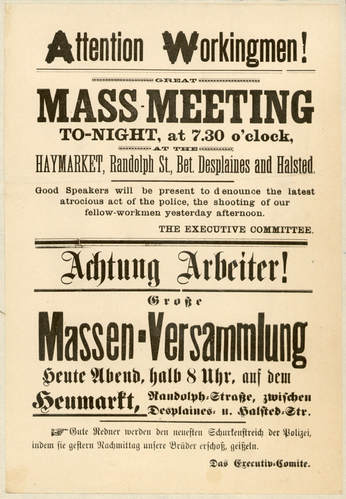 What we do know is that workers planned a meeting to protest police brutality the next day in Haymarket Square. Some fifteen hundred people showed up and protested peacefully. After most of the crowd had gone home, police marched out in force to disburse the remaining crowd. Suddenly a pipe bomb exploded among police ranks panicking everyone. Police opened fire on the crowd. The bomb killed seven policemen. At least four civilians were shot and more than sixty demonstrators injured. A frenzy swept Chicago that night as police rounded up labor leaders and suspected radicals. In addition they arrested hundreds of workers, many of whom were interrogated and beaten. No evidence ever identified who threw the bomb. Eight men stood trial, four hanged. Historians still debate the accuracy of the charges and fairness of the trial. The Haymarket Affair delayed the 8-hour day and kindled xenophobia against radicals and immigrants that haunted labor unions for decades and continues in America today. Our kids are taught that this protest against police brutality, this strike for the eight-hour workday, was a riot by workers. To make sense of political issues today like "the right to work," "Obama Care," and immigration. Kids need to know American labor history. 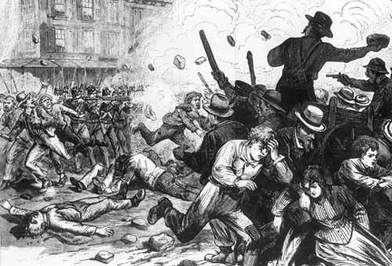 1877 clash between workers and Maryland Sixth Regiment, which the governor deployed on behalf of the railroad company. 1877 clash between workers and Maryland Sixth Regiment, which the governor deployed on behalf of the railroad company. The Library of Congress puts out curriculum aides for teachers on all sorts of history topics. You may or may not be shocked at the wording of their labor history lesson. "One especially significant labor upheaval was the Great Railroad Strike of 1877. Wage cuts in the railroad industry led to the strike, which began in West Virginia and spread to three additional states over a period of 45 days before being violently ended by a combination of vigilantes, National Guardsmen, and federal troops. Similar episodes occurred more frequently in the following decades as workers organized and asserted themselves against perceived injustices." Will you do one thing today to help America's kids learn a balanced view of our labor history? Click here for a round-up of great books for kids on the topic. Then call your public library and ask them to stock one or two of them. Better yet, purchase one and donate it to your local school. Thanks so much! |
I'm fascinated to discover little-known history, stories of people and events that provide a new perspective on why and how things happened, new voices that haven't been heard, insight into how the past brought us here today, and how it might guide us to a better future.
I also post here about my books and feature other authors and their books on compelling and important historical topics. Occasionally, I share what makes me happy, pictures of my garden, recipes I've made, events I've attended, people I've met. I'm always happy to hear from readers in the blog comments, by email or social media. Archives
September 2023
Categories
All
|
